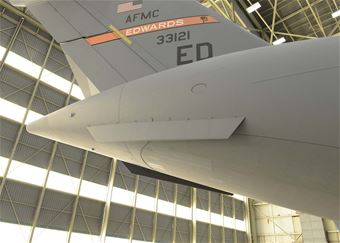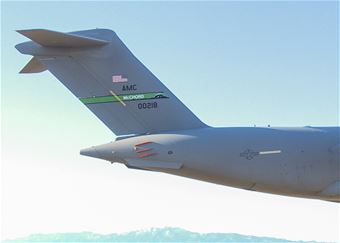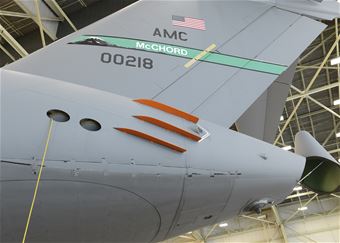It looks like you're using an Ad Blocker.
Please white-list or disable AboveTopSecret.com in your ad-blocking tool.
Thank you.
Some features of ATS will be disabled while you continue to use an ad-blocker.
4
share:
A C-17 from Joint Base Lewis-McChord has been at Edwards testing drag reduction methods. The C-17 is a very costly aircraft in terms of fuel
consumption, so the Air Force is looking at different ways to reduce the drag, and save even a few percentage points of fuel consumption with them. A
couple percent fuel consumption reduction could save several million dollars over the course of a year. In 2012, the C-130, C-5, and C-17 used 70% of
the fuel purchased, with the C-17 being the highest of the three.
The first test, which was completed in March, involved removing the double strakes under the aft fuselage, and replacing them with three Vortex Control Technologies Finlets on either side of the fuselage, to see how they perform compared to the strakes. The next phase, will increase the number of Finlets to 16, by adding 5 more on each side of the aircraft. The third phase, will remove the Finlets, and add six microvanes instead. The microvanes are small plastic blade shaped protrusions. The fourth and final phase will see fairings attached on the wings near the engines and winglets.
After completion of the testing, this October, the data will be sent to the AFRL at Wright-Patterson to determine which, if any, of the modifications reduce drag, and by how much. If any of them reduce drag, while not impacting the current capabilities of the aircraft, we may see them added on in place of the strakes in coming years.
www.edwards.af.mil...
C-17 standard configuration with strakes:

With both Finlets and strakes, testing aerodynamics:

With strakes removed and Finlets added:

The first test, which was completed in March, involved removing the double strakes under the aft fuselage, and replacing them with three Vortex Control Technologies Finlets on either side of the fuselage, to see how they perform compared to the strakes. The next phase, will increase the number of Finlets to 16, by adding 5 more on each side of the aircraft. The third phase, will remove the Finlets, and add six microvanes instead. The microvanes are small plastic blade shaped protrusions. The fourth and final phase will see fairings attached on the wings near the engines and winglets.
After completion of the testing, this October, the data will be sent to the AFRL at Wright-Patterson to determine which, if any, of the modifications reduce drag, and by how much. If any of them reduce drag, while not impacting the current capabilities of the aircraft, we may see them added on in place of the strakes in coming years.
From testing synthetic biofuels to "vortex surfing," Edwards AFB is on the forefront of finding new ways to cut fuel costs for the Air Force.
The latest venture is currently underway at the 418th Flight Test Squadron where a test team of Air Force and Boeing personnel has just completed the first phase of Air Force Research Laboratory's C-17 Drag Reduction Program.
According to an AFRL study, the price the U.S. Air Force pays for jet fuel has quadrupled between 2004 and 2012. At the same time, the demand for personnel and equipment to be transported around the world has increased. Airlifters like the C-130, C-17 and C-5, use most of the Air Force's fuel; 70% in 2012. Of these cargo planes, the C-17 uses the most fuel.
The purpose of the C-17 Drag Reduction Program is to collect data on how airflow is effected with different modifications done to a C-17 Globemaster III.
www.edwards.af.mil...
C-17 standard configuration with strakes:

With both Finlets and strakes, testing aerodynamics:

With strakes removed and Finlets added:

a reply to: Zaphod58
If they never change the design of the airplane it will only improve so much.
I really dont get why we dont try a new design.
Its the same flying tube it was over a half a century ago.
It doesnt have to be from the future, but this is the SAME design. Try something new.
If they never change the design of the airplane it will only improve so much.
I really dont get why we dont try a new design.
Its the same flying tube it was over a half a century ago.
It doesnt have to be from the future, but this is the SAME design. Try something new.
a reply to: Zaphod58
I guess but how long will that same logic be used? 150 years?
We are losing our edge.
Its time we learn what other designs can do. We seem to learn allot about fighter designs that are innovative and revolutionary, and not so much as far as designs that can carry over to the civilian world. Unless we start using flying wings we havent learned how to move large quantities of things that arent bombs in a more effective way.
Its like medical advancements lagging behind cosmetic advancements. Sure we are still curing cancer but we spend half of our efforts on making rich people look beautiful, or making them rich.
It seems like all innovation goes to fighter planes and drones, and nothing that can be useful to the civilian world. Its not even productive to the military since now we have fuel concerns and we are playing with plastic wings on an old design we absolutely could improve on...if we wanted to.
I guess but how long will that same logic be used? 150 years?
We are losing our edge.
Its time we learn what other designs can do. We seem to learn allot about fighter designs that are innovative and revolutionary, and not so much as far as designs that can carry over to the civilian world. Unless we start using flying wings we havent learned how to move large quantities of things that arent bombs in a more effective way.
Its like medical advancements lagging behind cosmetic advancements. Sure we are still curing cancer but we spend half of our efforts on making rich people look beautiful, or making them rich.
It seems like all innovation goes to fighter planes and drones, and nothing that can be useful to the civilian world. Its not even productive to the military since now we have fuel concerns and we are playing with plastic wings on an old design we absolutely could improve on...if we wanted to.
edit on 3 31 2016 by tadaman because: (no reason given)
a reply to: tadaman
We're not losing our edge, everyone else is in the same boat when it comes to civil design. There's only so much you can do with a civil aircraft, that doesn't make the passengers freak out. A flying wing will make a terrible passenger aircraft, and will have a larger ramp footprint than a tube design of similar size. Yes it can carry more, but airports are designed for tube designs, and are optimized for them. Making a radical change will cost a lot. Just look at the changes and upgrades required for the A380.
It's not fuel concerns, it's trying to save money. Everyone that flies an aircraft is doing it, which is why aircraft like the A350 and 787 are flying, and Rolls Royce, GE, and Pratt&Whitney are coming out with radical new engines that save a huge percentage over engine types that are only 10-15 years old.
We're not losing our edge, everyone else is in the same boat when it comes to civil design. There's only so much you can do with a civil aircraft, that doesn't make the passengers freak out. A flying wing will make a terrible passenger aircraft, and will have a larger ramp footprint than a tube design of similar size. Yes it can carry more, but airports are designed for tube designs, and are optimized for them. Making a radical change will cost a lot. Just look at the changes and upgrades required for the A380.
It's not fuel concerns, it's trying to save money. Everyone that flies an aircraft is doing it, which is why aircraft like the A350 and 787 are flying, and Rolls Royce, GE, and Pratt&Whitney are coming out with radical new engines that save a huge percentage over engine types that are only 10-15 years old.
edit on 3/31/2016 by Zaphod58 because: (no reason given)
Never heard of the term "strake". On the f-15 we called them vortex generators and they were primarily there to force the body-mounted Aim-7's away
from the jet upon release.
I suppose they've identified the rear as a big drag point, but improving airflow from the beginning is the best way to deal with drag, not fight it at the tail.
Alas, it's probably a cost-saving measure. It's cheap to add those surfaces compared to a more aerodynamic nose and wing convergence area.
I suppose they've identified the rear as a big drag point, but improving airflow from the beginning is the best way to deal with drag, not fight it at the tail.
Alas, it's probably a cost-saving measure. It's cheap to add those surfaces compared to a more aerodynamic nose and wing convergence area.
edit on 31-3-2016 by Tempter because: Sp
a reply to: Tempter
A vortex generator and strake are slightly different. The vortex generator is used to improve efficency, and for some boundary layer control. Strakes are placed under the aft fuselage to help with stability, such as on the F-16. A strake can be a vortex generator, but not all vortex generators are strakes kind of thing.
A vortex generator and strake are slightly different. The vortex generator is used to improve efficency, and for some boundary layer control. Strakes are placed under the aft fuselage to help with stability, such as on the F-16. A strake can be a vortex generator, but not all vortex generators are strakes kind of thing.
OK, those are some ugly joints where the strake meets the fuselage. I can see issues with the doors open in flight and the strakes helping.
There are coatings that help with drag but if the ROI is longer than the lifespan of the airframe it doesn't make sense.
I also don't see a flying wing being being very passenger friendly in terms of greenhouse area to passenger area. I am not sure how severe weather landing friendly they will be and they are certainly not unusual attitude friendly.
Shorts Brothers had some boxy fuses that made the aircraft a little more efficient since they produces some lift, but I can't see that being great for a pressurized vessel.
There are coatings that help with drag but if the ROI is longer than the lifespan of the airframe it doesn't make sense.
I also don't see a flying wing being being very passenger friendly in terms of greenhouse area to passenger area. I am not sure how severe weather landing friendly they will be and they are certainly not unusual attitude friendly.
Shorts Brothers had some boxy fuses that made the aircraft a little more efficient since they produces some lift, but I can't see that being great for a pressurized vessel.
Our Nuke arsenal is rusting away and Obama has them trying to save gas on a C-17? sigh
a reply to: Xeven
Obama doesn't have a damn thing to do with this. The Air Force has been trying to save money on fuel for years.
I get that it's cool to hate on Obama, but believe it or not, he doesn't make every single decision about every single thing that goes on.
In case you missed it, let me repeat this. In 2012, 70% of all fuel used was by the C-130, C-5, and C-17, with the latter using the most of those three.
Obama doesn't have a damn thing to do with this. The Air Force has been trying to save money on fuel for years.
I get that it's cool to hate on Obama, but believe it or not, he doesn't make every single decision about every single thing that goes on.
In case you missed it, let me repeat this. In 2012, 70% of all fuel used was by the C-130, C-5, and C-17, with the latter using the most of those three.
edit on 4/2/2016 by Zaphod58 because: (no reason given)
new topics
-
America's Greatest Ally
General Chit Chat: 33 minutes ago -
President BIDEN's FBI Raided Donald Trump's Florida Home for OBAMA-NORTH KOREA Documents.
Political Conspiracies: 5 hours ago -
Maestro Benedetto
Literature: 7 hours ago -
Is AI Better Than the Hollywood Elite?
Movies: 7 hours ago -
Las Vegas UFO Spotting Teen Traumatized by Demon Creature in Backyard
Aliens and UFOs: 10 hours ago -
2024 Pigeon Forge Rod Run - On the Strip (Video made for you)
Automotive Discussion: 11 hours ago -
Gaza Terrorists Attack US Humanitarian Pier During Construction
Middle East Issues: 11 hours ago
top topics
-
President BIDEN's FBI Raided Donald Trump's Florida Home for OBAMA-NORTH KOREA Documents.
Political Conspiracies: 5 hours ago, 26 flags -
Krystalnacht on today's most elite Universities?
Social Issues and Civil Unrest: 16 hours ago, 9 flags -
Gaza Terrorists Attack US Humanitarian Pier During Construction
Middle East Issues: 11 hours ago, 8 flags -
Supreme Court Oral Arguments 4.25.2024 - Are PRESIDENTS IMMUNE From Later Being Prosecuted.
Above Politics: 16 hours ago, 8 flags -
Weinstein's conviction overturned
Mainstream News: 15 hours ago, 8 flags -
Massachusetts Drag Queen Leads Young Kids in Free Palestine Chant
Social Issues and Civil Unrest: 13 hours ago, 7 flags -
Las Vegas UFO Spotting Teen Traumatized by Demon Creature in Backyard
Aliens and UFOs: 10 hours ago, 6 flags -
Meadows, Giuliani Among 11 Indicted in Arizona in Latest 2020 Election Subversion Case
Mainstream News: 13 hours ago, 5 flags -
2024 Pigeon Forge Rod Run - On the Strip (Video made for you)
Automotive Discussion: 11 hours ago, 4 flags -
Is AI Better Than the Hollywood Elite?
Movies: 7 hours ago, 3 flags
active topics
-
How ageing is" immune deficiency"
Medical Issues & Conspiracies • 35 • : annonentity -
HORRIBLE !! Russian Soldier Drinking Own Urine To Survive In Battle
World War Three • 49 • : Freeborn -
Gaza Terrorists Attack US Humanitarian Pier During Construction
Middle East Issues • 30 • : Asher47 -
Electrical tricks for saving money
Education and Media • 8 • : anned1 -
Is AI Better Than the Hollywood Elite?
Movies • 16 • : 5thHead -
Hate makes for strange bedfellows
US Political Madness • 48 • : Terpene -
America's Greatest Ally
General Chit Chat • 0 • : 19Bones79 -
President BIDEN's FBI Raided Donald Trump's Florida Home for OBAMA-NORTH KOREA Documents.
Political Conspiracies • 17 • : BingoMcGoof -
Supreme Court Oral Arguments 4.25.2024 - Are PRESIDENTS IMMUNE From Later Being Prosecuted.
Above Politics • 90 • : Lumenari -
Las Vegas UFO Spotting Teen Traumatized by Demon Creature in Backyard
Aliens and UFOs • 12 • : KrustyKrab
4
